Breaking
News :-- Taj Mahal has been incl;uded in the seven wonders of the
world and more...
THE NEW 7 WONDERS OF THE WORLD
The New7Wonders organization is happy
to announce the following 7 candidates have been elected to represent global
heritage throughout history.
|
Taj Mahal has been incl;uded in the seven
wonders of the world.
LISBON, Portugal: The
Taj Mahal, the Great Wall of China, Greece's Acropolis and Peru's Machu
Picchu were leading contenders to be among the new seven wonders of the
world in a global poll whose results were to be announced Saturday.
The Taj Mahal, regarded
as one of the most beautiful monuments, was tonight voted in a global poll
as one of the new seven wonders of the world.
Officials of the I Media
Corp, the Indian representative of 'New7wonders of the World', claimed
that they got the information about the Mughal marvel getting into the
list from the Swiss organisation which organised the worldwide campaign
Also in the top 10 after
votes were cast by more than 90 million people are the Colosseum in Rome,
Mexico's Chichen Itza pyramid, the Eiffel Tower, Easter Island, Brazil's
Statue of Christ Redeemer and Jordan's Petra.
The winners were to be
announced at a ceremony in Lisbon, Portugal.
The Great Pyramids of
Giza, the only surviving structures from the original seven wonders of
the ancient world, are to retain their status in addition to the new seven.
People from every country
in the world voted by Internet or by phone message for the world's top
architectural marvels, the nonprofit organization conducting the balloting,
called
The Colosseum, the Great
Wall, Machu Picchu, India's Taj Mahal and Petra have been among the leaders
since January. The Acropolis and the Statue of Christ Redeemer recently
received a surge in votes.
The United States' Statue
of Liberty and Australia's Sydney Opera House have been sitting near the
bottom from the start.
Also in the less-voted
group are Cambodia's Angkor, Spain's Alhambra, Turkey's Hagia Sophia, Japan's
Kiyomizu Temple, Russia's Kremlin and St. Basil's Cathedral, Germany's
Neuschwanstein Castle, Britain's Stonehenge and Mali's Timbuktu.
The campaign was begun
in 1999 by Swiss adventurer Bernard Weber. Almost 200 nominations came
in from around the world, and the list of candidates was narrowed down
to the 21 most-voted by the start of 2006.
The organizers conceded
there was no foolproof way to prevent people from voting more than once
for their favorite.
Weber's Switzerland-based
foundation aims to promote cultural diversity by supporting, preserving
and restoring monuments. It relies on private donations and revenue from
selling broadcasting rights.
The United Nations Educational,
Scientific and Cultural Organization, or UNESCO, keeps a list of World
Heritage Sites, which now totals 851 places, but the agency was not involved
in Weber's project.
The original list of wonders
were concentrated in the Mediterranean and Middle East. The Hanging Gardens
of Babylon, the Statue of Zeus at Olympia, the Temple of Artemis at Ephesus,
the Mausoleum of Halicarnassus, the Colossus of Rhodes and the Pharos lighthouse
off Alexandria have all vanished.
The New7Wonders of the
World
were announced tonight in a star-studded ceremony featuring a fanfare of
musical performances and a parade of world dignitaries. All came together
for one night to highlight the world's cultural gems and shared heritage.
The New7Wonders of the
World, in random order, are: Taj Mahal, The Great Wall of China, Petra,
Chichén Itzá , the Statue of Christ Redeemer, the Colosseum
and the Machu Picchu. More than 100 million votes were cast worldwide. |
Contest to New 7 World
Wonders
GENEVA, Switzerland - November
13, 2006 - A global competition to name the new seven wonders of the world
is attracting widespread interest, with more than 20 million people voting
so far, organizers say. Candidates for the new list have been narrowed
down to 21, including the Taj Mahal, Stonehenge, the Acropolis and the
Great Wall of China. The public can vote until July 6, 2007, by Internet
or phone. The seven winners will be announced July 7 in Lisbon, Portugal.
The Egyptian pyramids are
also on the list, and they are the only surviving structures from the original
list of seven architectural marvels. Long gone are the Hanging Gardens
of Babylon, the Statue of Zeus at Olympia, the Temple of Artemis at Ephesus,
the Mausoleum of Halicarnassus, the Colossus of Rhodes and the Pharos lighthouse
off Alexandria. Those seven were deemed wonders in ancient times by observers
of the Mediterranean and Middle East.
Choosing world wonders has
been a continuing fascination over the centuries. The United Nations Educational,
Scientific and Cultural Organization, or UNESCO, keeps updating its list
of World Heritage Sites, which now totals 830 places.
The "New 7 Wonders of the
World" campaign was begun in 1999 by Swiss adventurer Bernard Weber, with
almost 200 nominations coming in from around the world.
Weber "felt it is time for
something new to bring the world together" and to "symbolize a common pride
in the global cultural heritage," said Tia B. Viering, spokeswoman for
the campaign.
Weber's Switzerland-based
foundation aims to promote cultural diversity by supporting, preserving
and restoring monuments. It relies on private donations and revenue from
selling broadcasting rights.
Nominations were whittled
down by public votes to 77 last year. Then a panel of architectural experts,
chaired by former UNESCO chief Federico Mayor, shortened the list to 21.
Interest has grown as Weber and his 10-member team visit the 21 sites.
Their final visit will be March 6 to New York's Statue of Liberty.
In addition to the Taj Mahal,
Stonehenge, the Acropolis, the Great Wall and the Pyramids, the candidates
are the Statue of Liberty; Eiffel Tower; Peru's Machu Picchu; Turkey's
Haghia Sophia; the Kremlin and St. Basil's Cathedral; the Colosseum; Germany's
Neuschwanstein Castle; Spain's Alhambra; Japan's Kiyomizu Temple; the Sydney
Opera House; Cambodia's Angkor; Timbuktu; Petra, Jordan; Brazil's Statue
of Christ Redeemer; Easter Island; and Chichen Itza, Mexico.
Here are descriptions of
the 21 candidates.
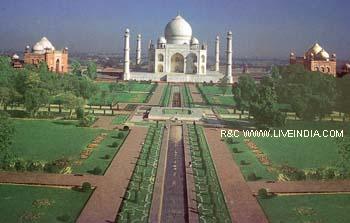 TAJ
MAHAL, INDIA: The white marble-domed mausoleum in Agra was built
by a 17th century Mogul emperor for his favorite wife, who died in childbirth.
The architecture combines Indian, Persian, and Islamic styles. The complex
houses the graves of the emperor, his wife, and other royalty. more....
TAJ
MAHAL, INDIA: The white marble-domed mausoleum in Agra was built
by a 17th century Mogul emperor for his favorite wife, who died in childbirth.
The architecture combines Indian, Persian, and Islamic styles. The complex
houses the graves of the emperor, his wife, and other royalty. more....

ACROPOLIS,
GREECE: A million people come here each year to see the marble
temples - including the ruins of the columned Parthenon - and statues of
Greek gods and goddesses dating from the fifth century B.C.
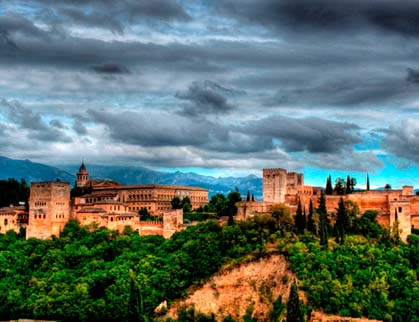
ALHAMBRA, SPAIN: The
palace and citadel, perched above Granada, was the residence of the Moorish
caliphs who governed southern Spain in splendor until 1492, when the city
was conquered by the Christian forces of King Ferdinand and Queen Isabella,
ending 800 years of Muslim rule. Stunning features include mosaics, arabesques
and mocarabe, or honeycomb work.
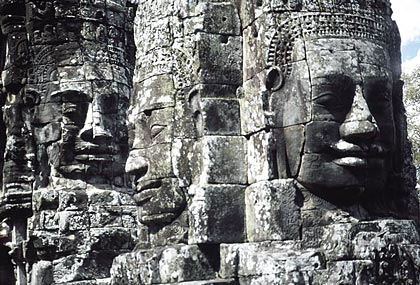 ANGKOR, CAMBODIA: The
archaeological site in Siem Reap was the capital of the Khmer (Cambodian)
empire from the ninth to 15th centuries. It served as administrative center
and place of worship for a prosperous kingdom that stretched from Vietnam
to China and the Bay of Bengal. The 12th century ruins include Angkor Wat
and Angkor Thom.
ANGKOR, CAMBODIA: The
archaeological site in Siem Reap was the capital of the Khmer (Cambodian)
empire from the ninth to 15th centuries. It served as administrative center
and place of worship for a prosperous kingdom that stretched from Vietnam
to China and the Bay of Bengal. The 12th century ruins include Angkor Wat
and Angkor Thom.
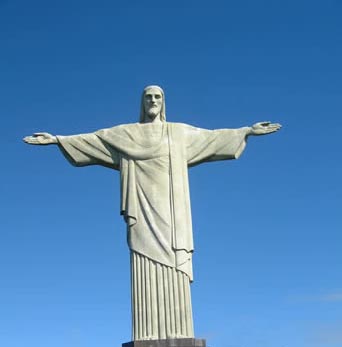
CHRIST
REDEEMER STATUE, BRAZIL: The 125-foot statue of Christ the Redeemer
with outstretched arms overlooks Rio de Janeiro from atop Mount Corcovado.
The statue was built in pieces in France starting in 1926, and shipped
to Brazil. A railway carried it up the 2,343-foot mountain for the 1931
inauguration.

COLOSSEUM,
ITALY: The 50,000-seat amphitheater in Rome was inaugurated in
A.D. 80. Thousands of gladiators dueled to the death here, and Christians
were fed to the lions. The arena has influenced the design of modern stadiums.
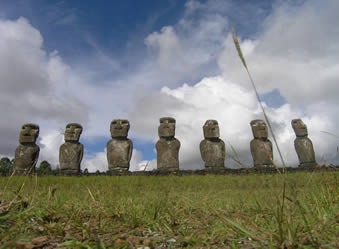
EASTER ISLAND, CHILE:
Hundreds of massive stone busts, or Moais, are all that remains from the
prehistoric Rapanui culture that crafted them between 400 and 1,000 years
ago to represent deceased ancestors. Some statues are over 70 feet tall.
They gaze out on the south Pacific Ocean more than 1,000 miles off the
Chilean mainland.
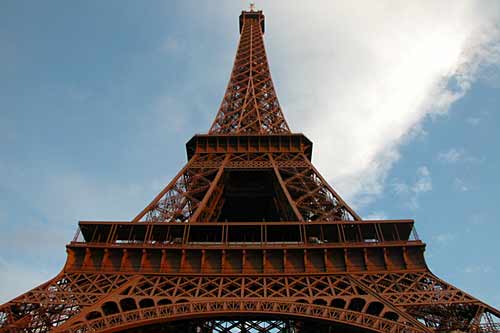
EIFFEL
TOWER, FRANCE: The 985-foot tower, built in 1889 for the International
Exposition, symbolizes Paris. Made almost entirely of open-lattice wrought
iron and erected in only two years with a small labor force, the tower
- Paris' tallest structure - demonstrated advances in construction techniques,
but some initially criticized it as unaesthetic.
GREAT WALL OF CHINA:
The 4,160-mile barricade running from east to west is the world's longest
man-made structure. The fortification was built to protect various dynasties
from invasion by Huns, Mongols, Turks and other nomadic tribes. Construction
took place over hundreds of years, beginning in the seventh century B.C.
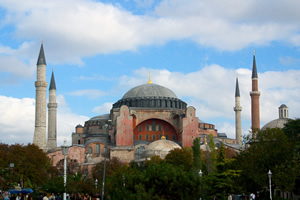
HAGIA SOPHIA, TURKEY:
The soaring cathedral, also called the Church of Holy Wisdom, was built
in 537 B.C. at Constantinople, today's Istanbul. In 1453, when Constantinople
fell to the Ottomans, it became a mosque with minarets. When Turkish President
Kemal Ataturk turned it into a museum in 1935, Christian mosaics covered
up by the Muslims were revealed.
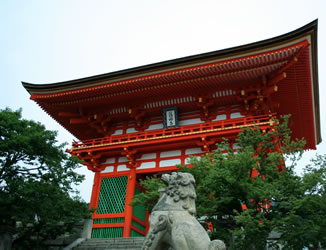 KIYOMIZU
TEMPLE, JAPAN: Kyoto's Kiyomizu-dera, which means Clear Water Temple,
was founded by a Buddhist sect in 798 and rebuilt in 1633 after a fire.
Drinking from its three-stream waterfall is believed to confer health,
longevity and success.
KIYOMIZU
TEMPLE, JAPAN: Kyoto's Kiyomizu-dera, which means Clear Water Temple,
was founded by a Buddhist sect in 798 and rebuilt in 1633 after a fire.
Drinking from its three-stream waterfall is believed to confer health,
longevity and success.
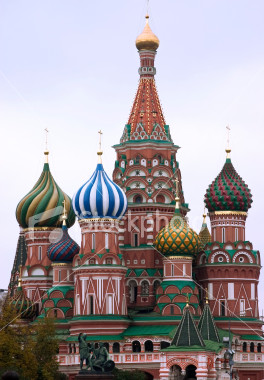 KREMLIN
AND ST. BASIL'S CATHEDRAL, RUSSIA: Onion domes with golden cupolas
surrounded by red brick walls are at the heart of Moscow's Kremlin, a Medieval
fortress converted into the center of Russian government. The Kremlin once
symbolized Soviet communism. The Cathedral of St. Basil the Blessed on
adjacent Red Square features nine towers of different colors. It was built
by Czar Ivan the Terrible in the mid-16th century.
KREMLIN
AND ST. BASIL'S CATHEDRAL, RUSSIA: Onion domes with golden cupolas
surrounded by red brick walls are at the heart of Moscow's Kremlin, a Medieval
fortress converted into the center of Russian government. The Kremlin once
symbolized Soviet communism. The Cathedral of St. Basil the Blessed on
adjacent Red Square features nine towers of different colors. It was built
by Czar Ivan the Terrible in the mid-16th century.
 MACHU PICCHU, PERU: Built
by the Incan Empire in the 15th century, Machu Picchu's walls, palaces,
temples and dwellings are perched in the clouds at 8,000 feet above sea
level in the Andes overlooking a lush valley 310 miles from Lima.
MACHU PICCHU, PERU: Built
by the Incan Empire in the 15th century, Machu Picchu's walls, palaces,
temples and dwellings are perched in the clouds at 8,000 feet above sea
level in the Andes overlooking a lush valley 310 miles from Lima.
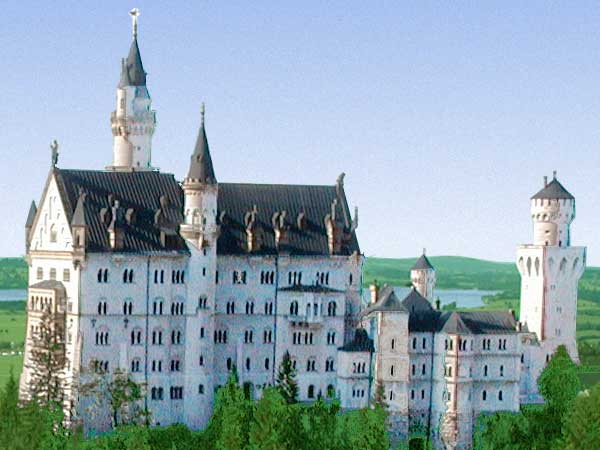 NEUSCHWANSTEIN
CASTLE, GERMANY: The inspiration for the Sleeping Beauty Castle
at Disneyland, Neuschwanstein is a creation of "Mad King" Ludwig II of
Bavaria, who had it built in the 19th century to indulge his romantic fancies.
Perched on a peak in the Bavarian Alps, the gray granite castle rises to
towers, turrets and pinnacles and contains many paintings with scenes from
Richard Wagner operas admired by Ludwig.
NEUSCHWANSTEIN
CASTLE, GERMANY: The inspiration for the Sleeping Beauty Castle
at Disneyland, Neuschwanstein is a creation of "Mad King" Ludwig II of
Bavaria, who had it built in the 19th century to indulge his romantic fancies.
Perched on a peak in the Bavarian Alps, the gray granite castle rises to
towers, turrets and pinnacles and contains many paintings with scenes from
Richard Wagner operas admired by Ludwig.
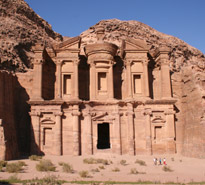 PETRA, JORDAN: This ancient
city in southwestern Jordan, built on a terrace around the Wadi Musa or
Valley of Moses, was the capital of the Arab kingdom of the Nabateans,
a center of caravan trade, and continued to flourish under Roman rule after
the Nabateans' defeat in A.D. 106. The city is famous for water tunnels
and stone structures carved in the rock, including Ad-Dayr, "the Monastery,"
an uncompleted tomb facade that served as a church during Byzantine times.
PETRA, JORDAN: This ancient
city in southwestern Jordan, built on a terrace around the Wadi Musa or
Valley of Moses, was the capital of the Arab kingdom of the Nabateans,
a center of caravan trade, and continued to flourish under Roman rule after
the Nabateans' defeat in A.D. 106. The city is famous for water tunnels
and stone structures carved in the rock, including Ad-Dayr, "the Monastery,"
an uncompleted tomb facade that served as a church during Byzantine times.
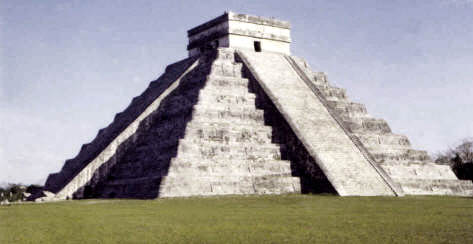 PYRAMID AT CHICHEN ITZA,
MEXICO: This step pyramid surmounted by a temple was part of a sacred
site in an important Mayan center on Mexico's Yucatan peninsula. It is
built according to the solar calendar. Shadows at the fall and spring equinoxes
are said to look like a snake crawling down the steps, similar to the carved
serpent at the top. An older pyramid inside features a jade-studded, red
jaguar throne.
PYRAMID AT CHICHEN ITZA,
MEXICO: This step pyramid surmounted by a temple was part of a sacred
site in an important Mayan center on Mexico's Yucatan peninsula. It is
built according to the solar calendar. Shadows at the fall and spring equinoxes
are said to look like a snake crawling down the steps, similar to the carved
serpent at the top. An older pyramid inside features a jade-studded, red
jaguar throne.
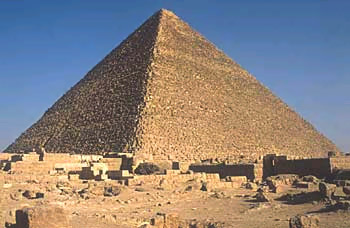 PYRAMIDS
OF GIZA, EGYPT: The only surviving structures of the original seven
wonders, the three pyramids were built as tombs for pharaohs 4,500 years
ago. Nearby is the Great Sphinx statue, with a man's face and a lion's
body.
PYRAMIDS
OF GIZA, EGYPT: The only surviving structures of the original seven
wonders, the three pyramids were built as tombs for pharaohs 4,500 years
ago. Nearby is the Great Sphinx statue, with a man's face and a lion's
body.
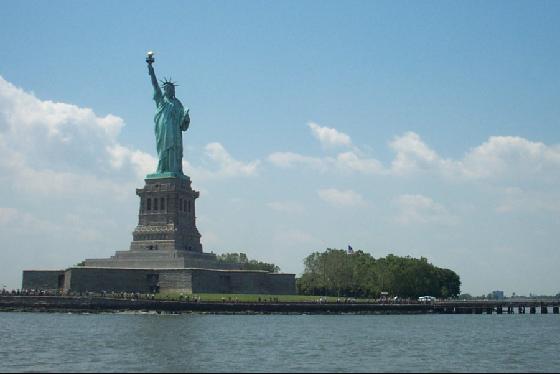 STATUE
OF LIBERTY, NEW YORK: The 305-foot statue in New York Harbor has
welcomed immigrants and symbolized freedom since 1886, when it was dedicated
as a gift of the French government.
STATUE
OF LIBERTY, NEW YORK: The 305-foot statue in New York Harbor has
welcomed immigrants and symbolized freedom since 1886, when it was dedicated
as a gift of the French government.
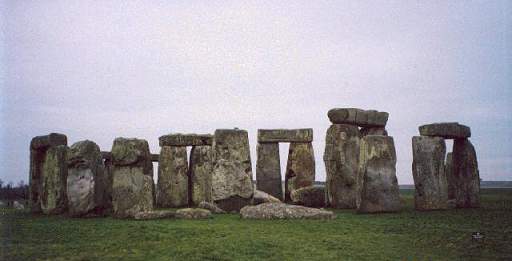 STONEHENGE,
BRITAIN: How and why this circular monument of massive rocks was
created between 3,000 and 1,600 B.C. is unknown, but some experts say the
stones were aligned as part of a sun-worshipping culture or astronomical
calendar. Today it is a major tourist attraction. Druids and New Age followers
gather here every June 21 to celebrate summer solstice.
STONEHENGE,
BRITAIN: How and why this circular monument of massive rocks was
created between 3,000 and 1,600 B.C. is unknown, but some experts say the
stones were aligned as part of a sun-worshipping culture or astronomical
calendar. Today it is a major tourist attraction. Druids and New Age followers
gather here every June 21 to celebrate summer solstice.
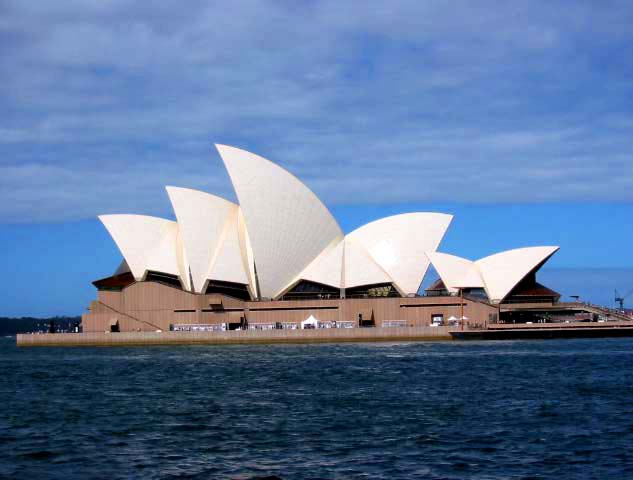 SYDNEY OPERA HOUSE, AUSTRALIA:
Situated on Bennelong Point reaching into Sydney's harbor, the opera house
was designed by Danish architect Jorn Utzon and opened in 1973 by Queen
Elizabeth II. Its roof resembles a ship in full sail and is covered by
over 1 million white tiles. The building has 1,000 rooms.
SYDNEY OPERA HOUSE, AUSTRALIA:
Situated on Bennelong Point reaching into Sydney's harbor, the opera house
was designed by Danish architect Jorn Utzon and opened in 1973 by Queen
Elizabeth II. Its roof resembles a ship in full sail and is covered by
over 1 million white tiles. The building has 1,000 rooms.
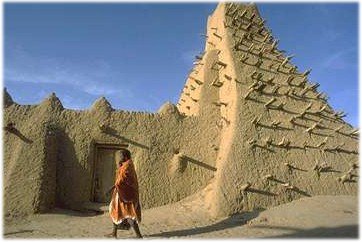
TIMBUKTU, MALI: Two of
West Africa's oldest mosques, the Djingareyber, or Great Mosque, and the
Sankore mosque built during the 14th and early 15th centuries can still
be seen here in the northern Sahara Desert. Founded about A.D. 1,100, Timbuktu
was a flourishing caravan center in the Arabic world and a leading spiritual
and intellectual center in the 15th and 16th centuries, with one of the
world's first universities.
|




















